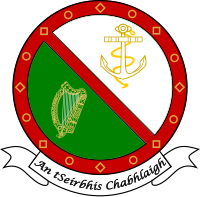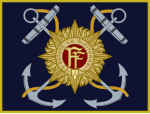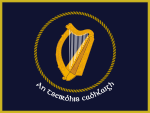Irish Navy
| Naval Service An tSeirbhís Chabhlaigh |
|
|---|---|

Emblem of the Naval Service
|
|
| Founded | 1 September 1946 |
| Country |
|
| Type | Navy |
| Role | Defence of the state and protection of its maritime resources |
| Size | 1,094 personnel 8 ships |
| Part of |
|
| Naval base | Haulbowline, County Cork, Ireland |
| Colours |
 
|
| Commanders | |
| FOCNS | Commodore Hugh Tully |
| Supreme Commander | Michael D. Higgins |
| Insignia | |
| Naval ensign | |
| Naval jack | |
The Naval Service (Irish: an tSeirbhís Chabhlaigh) is the maritime component of the Defence Forces of Ireland and is one of the three branches of the Irish Defence Forces. Its base is in Haulbowline, County Cork.
Though preceded by earlier maritime defence organisations, the Naval Service was formed in 1946. Since the 1970s a major role of the Naval Service has been the provision of fisheries protection in Ireland's exclusive economic zone (EEZ). Other roles include sea patrol, surveillance, and smuggling prevention. Occasionally the Service undertakes longer missions in support of other elements of the Defence Forces, Irish peacekeepers serving with the United Nations, or humanitarian and trade missions.
LÉ Eithne is the current flagship of the Naval Service.
The Anglo-Irish Treaty of 1921 stipulated that the Irish Free State would be given responsibility to police its customs and fishing, while the United Kingdom would remain in control of Irish waters. In 1923 the Coastal and Marine Service (CMS) was created, yet merely one year later it was disbanded.
During the Civil War, in August 1922, a ship belonging to the British & Irish Steam Packet Company, Lady Wicklow, led by Captain Patrick Ryan, was used to bring Irish National Army troops around the coast to Fenit, the port of Tralee in County Kerry. This naval involvement technically preceded the foundation of the Irish state, as Ireland was still part of the UK at the time. Built in 1890 in Dublin Dockyard, the ship measured 262 by 34 feet (80 by 10 m). In all 450 troops, including officers, were landed. Tralee was later captured from local republican forces.
Muirchú, formerly the British armed steam yacht Helga, which had been used by the Royal Navy to shell Dublin during the 1916 rising, was the only CMS ship during this period. The CMS ship Muirchu continued to patrol Irish fisheries. Muirchu was re-armed in 1936 and purchased by the Irish government on advice of members of the later named Maritime Institute of Ireland for fisheries protection.
...
Wikipedia


